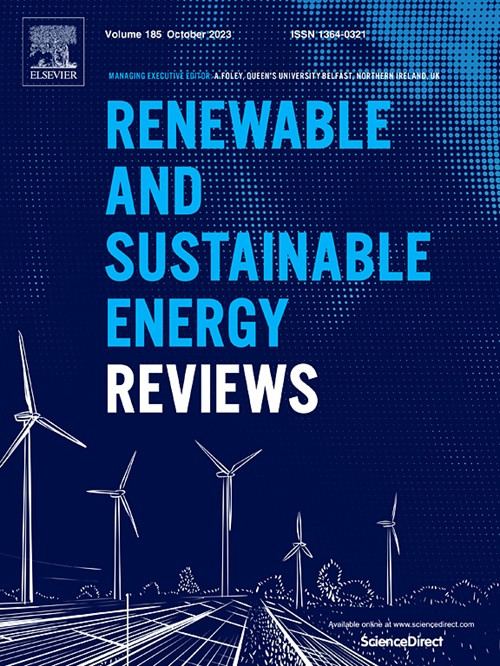柔性能源系统中的聚苯胺水凝胶:合成技术、混合结构、可持续性和技术经济分析
IF 16.3
1区 工程技术
Q1 ENERGY & FUELS
引用次数: 0
摘要
本文综述了用于下一代柔性储能系统的聚苯胺(PANI)基导电聚合物水凝胶(CPHs)的最新进展,揭示了其在合成方法、可持续发展和应用方面的重大改进。综述了表面活性剂、交联剂、共聚合和无粘结剂配方如何有效地获得优异的电化学性能和机械固体性。该分析揭示了通过与MXenes、石墨烯和碳纳米管等新兴材料的新型聚苯胺混合架构解决循环稳定性和电容衰减等关键挑战的进展。从辅助动态交联的聚苯乙烯/聚乙烯醇水凝胶片中还观察到特殊的比电容为936.8 F g−1,能量密度达到40.98 Wh kg−1。此外,双掺杂策略和控制结晶度导致稳定性显著提高,在10,000次循环后电容保持率超过92%。合成参数和性能指标之间的关键相关性表明,γ辐射诱导合成可以在保持优异导电性的同时将延伸率提高到1400%。对最佳孔隙率的控制使得高质量负载电极(>43.2 mg cm - 2)的开发具有出色的速率能力(从20到500 mA cm - 2保持92.7%)。新的冻融收缩处理和自愈机制已经产生了能够在极端条件下(- 30°C ~ 90°C)运行的机械坚固的设备。采用生物友好型掺杂剂和电解质的可持续生产方法减少了对环境的影响。这项工作还从技术经济的角度强调了生产可扩展性的最佳综合策略。这些发现为开发尖端柔性超级电容器建立了一个框架,对先进的便携式电子产品、可穿戴设备和电网规模的储能解决方案具有重要意义。本文章由计算机程序翻译,如有差异,请以英文原文为准。

Polyaniline hydrogel in flexible energy systems: Synthesis techniques, hybrid architecture, sustainability and techno-economic analysis
This review presents the progressive advances in polyaniline (PANI)-based conductive polymer hydrogels (CPHs) for next-generation flexible energy storage systems, revealing a significant improvement in synthesis methodologies, sustainable progress, and applications. The review demonstrates how surfactants, crosslinkers, co-polymerization, and binder-free formulations can effectively achieve superior electrochemical performance and mechanical solidity. The analysis uncovers the developments addressing key challenges like cycle stability and capacitance fading through novel hybrid architectures of PANI with emerging materials like MXenes, Graphene, and Carbon nanotubes. An exceptional specific capacitance of 936.8 F g−1 at 1 A g−1 and energy density reaching 40.98 Wh kg−1 is also observed from the assisted dynamically crosslinked PANI/PVA hydrogel sheet. Moreover, dual-doping strategies and controlled crystallinity have led to remarkable stability improvements, with capacitance retention exceeding 92 % after 10,000 cycles. Crucial correlations between synthesis parameters and performance metrics reveal that γ-radiation-induced synthesis can enhance elongation up to 1400 % while maintaining superior conductivity. The control of optimum porosity has enabled the development of high-mass-loading electrodes (>43.2 mg cm−2) with outstanding rate capability (92.7 % retention from 20 to 500 mA cm−2). Novel freeze-thaw-shrink treatments and self-healing mechanisms have produced mechanically robust devices capable of operating under extreme conditions (−30 °C∼90 °C). Sustainable production approaches incorporating bio-friendly dopants and electrolytes demonstrate reduced environmental impact. This work also emphasises the optimum synthesis strategies for production scalability from a techno-economic viewpoint. These findings establish a framework for developing cutting-edge flexible supercapacitors with significant implications for advanced portable electronics, wearable devices, and grid-scale energy storage solutions.
求助全文
通过发布文献求助,成功后即可免费获取论文全文。
去求助
来源期刊

Renewable and Sustainable Energy Reviews
工程技术-能源与燃料
CiteScore
31.20
自引率
5.70%
发文量
1055
审稿时长
62 days
期刊介绍:
The mission of Renewable and Sustainable Energy Reviews is to disseminate the most compelling and pertinent critical insights in renewable and sustainable energy, fostering collaboration among the research community, private sector, and policy and decision makers. The journal aims to exchange challenges, solutions, innovative concepts, and technologies, contributing to sustainable development, the transition to a low-carbon future, and the attainment of emissions targets outlined by the United Nations Framework Convention on Climate Change.
Renewable and Sustainable Energy Reviews publishes a diverse range of content, including review papers, original research, case studies, and analyses of new technologies, all featuring a substantial review component such as critique, comparison, or analysis. Introducing a distinctive paper type, Expert Insights, the journal presents commissioned mini-reviews authored by field leaders, addressing topics of significant interest. Case studies undergo consideration only if they showcase the work's applicability to other regions or contribute valuable insights to the broader field of renewable and sustainable energy. Notably, a bibliographic or literature review lacking critical analysis is deemed unsuitable for publication.
 求助内容:
求助内容: 应助结果提醒方式:
应助结果提醒方式:


